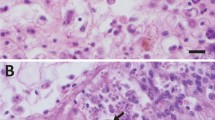Abstract
WITH reference to the article “Oysters and Typhoid,” which appeared in your last issue, it may interest your readers to know that De Giaxa investigated some years ago the behaviour of the typhoid bacillus in sea-water, both in its natural and sterilised condition. He found that in ordinary sea-water the typhoid bacillus suffered very considerably in the competition with the numerous other water bacteria present, but it was still identified on the ninth day after it was first introduced. In sea-water in which all other bacteria had been destroyed, the typhoid bacillus was detected in very appreciable numbers on the twenty-fifth day. More recently, however, the existence of typhoid bacilli in sterilised sea-water has been examined by Cassedebat, and his results are not in accord with those obtained by Giaxa. Cassedebat found that whilst many pathogenic bacteria, amongst which were those of anthrax and cholera, lived for several days, in the case of the former twenty-one to twenty-four days, and in that of the latter thirty-five days and even longer, typhoid bacilli were destroyed already in the course of forty-eight hours in sterilised sea-water. These results tend to confirm those obtained by Prof. Percy Frankland, who, in his last report to the Royal Society Water Research Committee, states that the addition of 1 and 3 per cent, of common salt to ordinary Thames water into which typhoid bacilli were introduced, acted very prejudicially on the latter, although it stimulated the multiplication of many forms of water bacteria present in a most astonishing manner. Similar results were obtained with salted but sterilised Thames water infected with typhoid bacilli, and not only did the latter disappear very rapidly, but the typhoid colonies which were obtained on plate-cultures from this salt water exhibited in some cases a very abnormal appearance, attributable to the degeneration of the typhoid bacilli under these conditions, for on passing such colonies through a further process of plate-culture, they returned to their ordinary type.
This is a preview of subscription content, access via your institution
Access options
Subscribe to this journal
Receive 51 print issues and online access
$199.00 per year
only $3.90 per issue
Buy this article
- Purchase on Springer Link
- Instant access to full article PDF
Prices may be subject to local taxes which are calculated during checkout
Similar content being viewed by others
Rights and permissions
About this article
Cite this article
FRANKLAND, G. Oysters and Typhoid. Nature 51, 415–416 (1895). https://doi.org/10.1038/051415a0
Issue Date:
DOI: https://doi.org/10.1038/051415a0
Comments
By submitting a comment you agree to abide by our Terms and Community Guidelines. If you find something abusive or that does not comply with our terms or guidelines please flag it as inappropriate.



